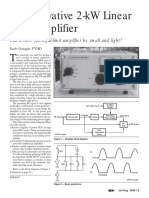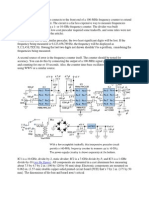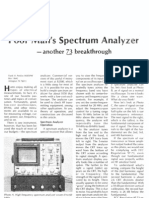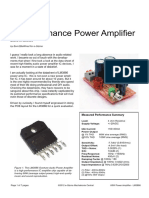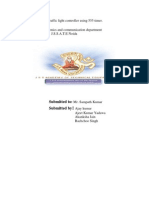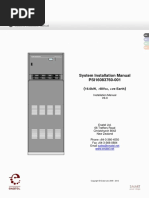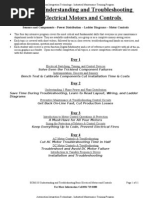Tranformer Polarity Tester
Tranformer Polarity Tester
Uploaded by
Слађана РикићCopyright:
Available Formats
Tranformer Polarity Tester
Tranformer Polarity Tester
Uploaded by
Слађана РикићOriginal Description:
Copyright
Available Formats
Share this document
Did you find this document useful?
Is this content inappropriate?
Copyright:
Available Formats
Tranformer Polarity Tester
Tranformer Polarity Tester
Uploaded by
Слађана РикићCopyright:
Available Formats
Transformer Polarity Tester
Build this simple box to check transformer polarity before you hook up your projects, which can save you a
boatload of frustration and woes and ensure peace of mind.
BY CHARLES HANSEN
W
hy would you be interested and no obvious polarity
in transformer polarity? Here markings? With multiple
are three examples in which secondaries, you can hook
polarity can have a definite impact: them up in series and ob-
serve which connection
1. You just finished a tube amplifier proj- gives the highest voltage,
ect. The last step is hooking up the nega- and therefore the correct
tive feedback to the speaker side of the phase relationship.
audio output transformer. Hook it up But this still doesn’t tell
wrong, and you will hear the howl of de- you the phase relation-
structive positive feedback oscillation. ship between primary and
secondaries. You can hook up PHOTO 1: The completed polarity tester.
2. You have an unmarked power trans- the transformer to a suitable AC voltage
former with two 120V AC primary wind- source and, with a dual-trace scope, ob- the windings. Since the change in current
ings, so it can be used on either 120 or serve the phase relation between prima- causes a proportional change in flux in
240V AC power mains. The windings ry and secondary waveforms to deter- the iron transformer core, a step output
must be paralleled to work properly with mine polarity. Or you can build this sim- voltage is developed in the other winding.
120V AC power lines. Hook up the wind- ple transformer polarity tester (Photo 1). In Fig. 1a the windings are in-phase
ings out-of-phase, and it’s a race as to (same polarity as shown by the winding
whether the fuse clears before the trans- HOW IT WORKS polarity dots). The output voltage will go
former windings burn out. ANSI/IEEE C57.12.80-1978 defines trans- positive and then decay back to zero as
former polarity as the relative instanta- the transformer flux collapses. In Fig. 1b
3. You have a step-down transformer neous direction of the currents in the the windings are out-of-phase, and the
with two equal secondary windings that windings of a transformer. Primary and output voltage will go negative and then
can be connected in series to double the secondary leads have the same polarity decay back to zero. My tester circuit (Fig.
output voltage. Hook up the windings when, at any given instant, the current 2) detects the polarity of the output volt-
out-of-phase, and instead of twice the enters the primary lead in question and age pulse and displays the decision using
voltage, you get nothing. leaves the secondary lead in question in one of two LEDs.
the same direction, as though the two The circuit is powered by a 12V DC
Fortunately, transformers usually have leads formed a continuous circuit. supply of at least 1A rating, connected to
diagrams or wire color codes to guide The principle of operation is shown in J1 and J2. Alternatively, you can use a
you in making the kinds of connections I Fig. 1, and it works between any two suitable 120V AC to 12V DC plug-in
just discussed. But what if you have a windings on multi-winding transformers. power adapter and install a mating
transformer with only the rating data, A positive voltage step is applied to one of 0.5mm power jack on the polarity tester
in lieu of J1 and J2.
The transformer leads that you con-
nect to the red terminals of the tester will
initially be the polarity-dotted leads, as
shown in Fig. 1.
The test is initiated by pressing mo-
ABOUT THE AUTHOR
Charles Hansen is an Engineering Consultant and
holds five patents in his field of electrical engineering.
He began building vacuum-tube audio equipment in
college. He plays jazz guitar and enjoys modifying gui-
tar amplifiers and effects to reduce noise and distortion,
G-1499-1ab as well as building and restoring audio test equipment.
He also has 40 magazine articles to his credit. He is
also author of the forthcoming book “The Joy of Audio
FIGURE 1: a) Windings in phase; b) windings out of phase. Electronics.”
1 GLASS AUDIO 6/99
mentary pushbutton switch S1. This ap- output voltage pulse across R2 will be out-of-phase connection will produce a
plies 12V DC through power resistor R1 negative and SCR1 will remain off. CR1 positive voltage pulse across R2 when S1
to the selected primary winding of the will clamp this voltage to protect the gate is released. If power isn’t removed from
transformer under test. It also applies of SCR1. With SCR1 off, Q1 will receive the indicating circuits at the same time
12V DC to the circuit, which monitors base drive through R4 and R5, turning on the DC current through the selected pri-
the output voltage pulse from the select- the red LED via R6. R4 is used to limit the mary is removed, SCR1 could fire and
ed secondary winding. voltage drop across the green LED to a give an erroneous indication.
If the windings are in-phase, a positive value below that where it illuminates. C1
voltage pulse will develop across R2 and prevents switching transients from false- CONSTRUCTION
couple to the gate of SCR1. This will firing SCR1. Figure 3 is a dimensioned drawing of the
cause SCR1 to fire, and anode current Once the test is complete and S1 is re- project box I used for the chassis. I used a
will flow through R3 and the green LED. leased, 12V DC is removed from the cir- four-position pushbutton speaker termi-
At the same time, the low ON voltage at cuit, and SCR1 can reset if it had been nal strip to allow fast and easy connec-
the anode of SCR1 will cut off the base triggered on. This is important, since re- tions to the transformer lead wires. In-
drive to Q1, preventing the red LED from moving the primary current will cause an stall the transformer test connector, the
illuminating. CR2 provides the additional opposite flux change in the transformer test switch, and the two power jacks on
voltage drop necessary to ensure that no core, producing an output pulse whose the top cover of the project box.
base voltage will appear at Q1. voltage polarity is the opposite of that Figure 4 shows the components layout
If the windings are out-of-phase, the produced when S1 was pressed. Thus, an and the wiring to the parts located off the
PC board. The 6 × 3³⁄₁₆ × 1⁷⁄₈-inch enclo-
sure shown in the components list (Table
1) has sufficient room for the perfboard
and chassis-mounted components. I
painted the cover white and used black
lettering for the various designations.
The semiconductor pin assignments are
also shown, from the top view. Note that
I used a TO-18 metal can 2N2222 transis-
tor. The plastic package may have a dif-
ferent pin layout.
I built the prototype on a wire-
wrapped perfboard. Since the gate circuit
of an SCR is sensitive to noise, I suggest
that you use the parts layout and the
connections for R2, CR1, and SCR1
shown in Fig. 4 to avoid a ground loop
with the primary current through R1,
which could false-trigger SCR1. Other-
G-1499-2
wise, the circuit layout is not critical. You
could even make yourself a PC board
FIGURE 2: Schematic of the polarity tester.
based on this layout.
In keeping with good assembly prac-
tice, install the least sensitive parts first,
followed by the more sensitive parts. Sol-
der in passive parts (resistors, then ca-
pacitor). Wire the leads from the circuit
board to the cover components. Finally,
install the semiconductors. Double-
check the orientation of the polarized
components.
The circuit board mounting holes use
four 4-40 screws with flat washers. In the
prototype the LED leads were ¾″ long,
and since I used ¾″ circuit board spac-
ers, the LEDs came through holes in the
project box cover without the need for
separate mounting lenses. You can see
this in the side view in Photo 2.
G-1499-3 SOURCES
Jameco (1-800-831-4242)
Radio Shack—local store
FIGURE 3: Project box layout.
2 GLASS AUDIO 6/99
PHOTO 2: Side view of unit with circuit board mounted to cover.
USING THE TESTER may be necessary to put more than one
You can connect any winding of the turn through the primary window so that
transformer under test to the tester as the sufficient voltage can be developed at the
“primary,” but the circuit works best if secondary to give a proper indication. If
you connect the lower impedance wind- all connections give a red LED indication,
ing to the primary terminals of the tester. more primary turns are needed. ❖
The current is higher and produces a
larger flux and a higher output pulse volt-
age. However, I successfully tested the cir- TABLE 1
cuit with numerous power, pulse, audio, PARTS LIST
and switching transformers using all the
C1 10nF, ceramic-disk
winding connection configurations. Due
CR1, CR2 1N914
to the possibility of high DC current in J1 Red binding post
the windings of small transformers, S1 J2 Black binding post
should be held down only long enough to LED1 Green T 1³⁄₄ LED
observe the polarity reading. LED2 Red T 1³⁄₄ LED
Q1 2N2222A NPN transistor
You should check both polarities when (Jameco p/n 38236 or equiv.)
using the tester to ensure that SCR1 is ac- R1 25Ω 10W wire-wound
tually receiving a gate pulse in one of the R2, R4 1k ¹⁄₄W 5%
two polarity positions. If both connec- R3, R6 680Ω ¹⁄₄W 5%
R5 10k ¹⁄₄W 5%
tions give a red LED indication, this sug-
SCR1 2N5062
gests that there may be some problem (Jameco p/n 120070 or equiv.)
with the transformer under test such as a S1 N.O. pushbutton switch
shorted turn, which you may not notice MISC: Project case (Radio Shack 270-223),
with an ohmmeter check. four-position pushbutton speaker termi-
nal strip (Radio Shack 274-622), hookup
The tester also works with toroidal cur- wire, standoffs, hardware, etc.
rent measuring transformers, although it
G-1499-4
FIGURE 4: Components layout.
GLASS AUDIO 6/99 3
You might also like
- Onkyo TX NR656 PDFDocument180 pagesOnkyo TX NR656 PDFboroda241091% (33)
- IP3005A - C181685 enDocument14 pagesIP3005A - C181685 enFernandoNo ratings yet
- Sencore Tube Set-Up BookDocument158 pagesSencore Tube Set-Up Bookentomophile67% (3)
- Audio Circuits Using The NE5532/34Document11 pagesAudio Circuits Using The NE5532/34Jose Simon Bolivar MoranNo ratings yet
- CH 4 - Oscillator Sem II 2015 UPLOADDocument53 pagesCH 4 - Oscillator Sem II 2015 UPLOADCHING HUI YEE STUDENT100% (1)
- Medidor de Fly Backs k7205Document6 pagesMedidor de Fly Backs k7205Alejandro ChiappesoniNo ratings yet
- PS 3 PDFDocument22 pagesPS 3 PDFDragoslav IvankovicNo ratings yet
- 2000 High Speed CMOS Data DL129-D c20000324Document408 pages2000 High Speed CMOS Data DL129-D c20000324Dara Nyara Ricardo SocorroNo ratings yet
- Supper Cascode CircuitDocument1 pageSupper Cascode Circuitapi-3701386No ratings yet
- 0-30 VDC Stabilized Power Supply With Current Control 0Document33 pages0-30 VDC Stabilized Power Supply With Current Control 0MarioKunditNo ratings yet
- Nafis Akhtar Gulam Gous Arham Ahmad 17eeb428 17eeb473 17EEB508 S.No: 62 S.No: 67 S.NO: 68Document16 pagesNafis Akhtar Gulam Gous Arham Ahmad 17eeb428 17eeb473 17EEB508 S.No: 62 S.No: 67 S.NO: 68Faizur Rahman100% (1)
- TV Emerson Wl20s5 BDocument54 pagesTV Emerson Wl20s5 Bgolberto1No ratings yet
- A Simple Tester For Audio Output TubesDocument2 pagesA Simple Tester For Audio Output Tubesjosue otoniel100% (1)
- Digital IC Projects RayerDocument100 pagesDigital IC Projects RayerBoshra BoshraNo ratings yet
- Eti 480 Diff AmpDocument7 pagesEti 480 Diff AmpCharlie SoutoNo ratings yet
- 2KW Qro PL519Document11 pages2KW Qro PL519adrcostache6515No ratings yet
- RB WobbulatorDocument8 pagesRB WobbulatorNestor Alberto Escala0% (2)
- Itb-05c Linearisation of ThermocoupleDocument20 pagesItb-05c Linearisation of Thermocouplekaushikei22No ratings yet
- 10-GHz Divide-By-100 Prescaler Connects To 100-MHz CounterDocument3 pages10-GHz Divide-By-100 Prescaler Connects To 100-MHz CounterAlex MarghNo ratings yet
- Bab 5 Oscillator 1448341865Document45 pagesBab 5 Oscillator 1448341865Eiqa Qa100% (1)
- Radio Electronics 1969 04Document92 pagesRadio Electronics 1969 04João L. BertoncelloNo ratings yet
- Most Often Needed: 1946 Radio DiagramsDocument191 pagesMost Often Needed: 1946 Radio DiagramsbrenodesenneNo ratings yet
- HiFi Mosfet AmpliferDocument8 pagesHiFi Mosfet AmpliferRajib ChatterjeeNo ratings yet
- Dual Tracking RegulatorDocument2 pagesDual Tracking RegulatorJCMNo ratings yet
- SRPP DesignDocument5 pagesSRPP Designandree wNo ratings yet
- RF-inductor Modeling For The 21st Century: DesignfeatureDocument5 pagesRF-inductor Modeling For The 21st Century: Designfeaturealessio8No ratings yet
- JLH Class-A Update: (Back To Index)Document10 pagesJLH Class-A Update: (Back To Index)Daniel ScardiniNo ratings yet
- 1938 - Beam Power Tubes 2 (Schade)Document46 pages1938 - Beam Power Tubes 2 (Schade)jazbo8No ratings yet
- Lab Manual Electric CircuitDocument23 pagesLab Manual Electric CircuitEngr. AbdullahNo ratings yet
- Capacitance and Inductance Measurements Using An Oscilloscope and A Function GeneratorDocument9 pagesCapacitance and Inductance Measurements Using An Oscilloscope and A Function Generatoralex castroNo ratings yet
- DC-DC ConverterDocument12 pagesDC-DC ConvertersabariNo ratings yet
- TheTransistorAmplifier P1Document63 pagesTheTransistorAmplifier P1Marcelo Napoleão BarrosNo ratings yet
- Leader LDC-823A - ManualDocument16 pagesLeader LDC-823A - Manual김박사No ratings yet
- 60-80W Power AmplifierDocument7 pages60-80W Power AmplifierBerrie SchwarzNo ratings yet
- Add Diode-Clipping Distortion To Your Guitar Amp - 6 Steps (With Pictures) PDFDocument17 pagesAdd Diode-Clipping Distortion To Your Guitar Amp - 6 Steps (With Pictures) PDFIñaki ToneMonsterNo ratings yet
- COLPITTS 1 To 20 MHZ Crystal Oscillator PDFDocument4 pagesCOLPITTS 1 To 20 MHZ Crystal Oscillator PDFArun Dutta100% (1)
- Measuring Nano AmperesDocument12 pagesMeasuring Nano Amperesvenustas08No ratings yet
- Peak DetectorDocument9 pagesPeak DetectorDHILDAAR100% (1)
- BK Precision Function GenaratorDocument60 pagesBK Precision Function Genarator9ioNo ratings yet
- FNIRSI-DC6006L English ManualDocument10 pagesFNIRSI-DC6006L English ManualmafmonteNo ratings yet
- Poor Mans Spectrum AnalyzerDocument11 pagesPoor Mans Spectrum AnalyzerYiannis GiannarakisNo ratings yet
- k111, Square Wave GeneratorDocument2 pagesk111, Square Wave GeneratorYasir AliNo ratings yet
- ESR Meter Al Lui GoDocument20 pagesESR Meter Al Lui GoLaurentiu IacobNo ratings yet
- Secrets On Power Supply Repair and Troubleshooting2Document3 pagesSecrets On Power Supply Repair and Troubleshooting2Gendil FatheNo ratings yet
- FP 10000 QDocument2 pagesFP 10000 QMoh IrfanNo ratings yet
- Lm3886-Egizmo DesignDocument7 pagesLm3886-Egizmo DesignKarloff Autencio100% (1)
- Bipolar Transistors FundamentalsDocument42 pagesBipolar Transistors FundamentalsHemal VyasNo ratings yet
- Servo BiasDocument3 pagesServo Biasdcastrelos2000No ratings yet
- LinearAudio v0 - A New Low-Noise Circuit Approach For PentodesDocument20 pagesLinearAudio v0 - A New Low-Noise Circuit Approach For PentodeslordoffDOCNo ratings yet
- La3600 PDFDocument8 pagesLa3600 PDFoink100% (1)
- P-N Junction DiodeDocument22 pagesP-N Junction DiodeRama SukumarNo ratings yet
- Add-On Stereo Channel Selector: Circuit IdeasDocument18 pagesAdd-On Stereo Channel Selector: Circuit IdeasNastasoiu NeluNo ratings yet
- Easy To Build Projects For Everyone: SEPT. 77Document42 pagesEasy To Build Projects For Everyone: SEPT. 77Jota NájeraNo ratings yet
- Traffic Light Controller Usin 555Document8 pagesTraffic Light Controller Usin 555Ajeet Yadav33% (3)
- Polarity Test TransformerDocument7 pagesPolarity Test TransformerPINEDA CRISTIAN PAUL C.No ratings yet
- Experiment 6 Electronic SwitchingDocument18 pagesExperiment 6 Electronic SwitchingrekcahNo ratings yet
- ELEC3105 Lab4Document10 pagesELEC3105 Lab4James AllenNo ratings yet
- Your Power Supply - : What The 'Scope Will ShowDocument5 pagesYour Power Supply - : What The 'Scope Will Showjulien9562No ratings yet
- 6.002 Spring 2019 Lab 12Document5 pages6.002 Spring 2019 Lab 12Matt StapleNo ratings yet
- E Transf 1 TH - 1Document4 pagesE Transf 1 TH - 1Crystal GarciaNo ratings yet
- TR231 or TR241 - 8112W00089 PDFDocument1 pageTR231 or TR241 - 8112W00089 PDFnk1224No ratings yet
- Siemens STEP 2000 Test Answer Form: Select The STEP 2000 Course You Are TestingDocument1 pageSiemens STEP 2000 Test Answer Form: Select The STEP 2000 Course You Are TestingManoj TyagiNo ratings yet
- Barker Microfarads (Radial Thru-Hole) 722D-723D SeriesDocument10 pagesBarker Microfarads (Radial Thru-Hole) 722D-723D Seriesester853No ratings yet
- Lithium Iron Battery Data SheetDocument4 pagesLithium Iron Battery Data Sheettam nguyenNo ratings yet
- Journal Pone 0287772Document24 pagesJournal Pone 0287772Asmaa A-ElghanyNo ratings yet
- Low Voltage Alternators - 4 Pole: Installation and MaintenanceDocument28 pagesLow Voltage Alternators - 4 Pole: Installation and MaintenanceJuan David Abadia LopezNo ratings yet
- How To Make Solenoid at Home?: InstructablesDocument4 pagesHow To Make Solenoid at Home?: InstructablesClóvis MorNo ratings yet
- Datasheet - Sun 3.6 8k sg05lp1 Eu - 240416 - enDocument2 pagesDatasheet - Sun 3.6 8k sg05lp1 Eu - 240416 - enmorad hassanNo ratings yet
- Manual - 12kW - PSI16083760-001 - Rev1Document23 pagesManual - 12kW - PSI16083760-001 - Rev1akolmakov72tumNo ratings yet
- Circutor User ManualDocument52 pagesCircutor User ManualNemitha LakshanNo ratings yet
- Ac Axial Fan FP-108-1: FP-108-1 Weight: Bearing System: Impeller: HousingDocument1 pageAc Axial Fan FP-108-1: FP-108-1 Weight: Bearing System: Impeller: HousingazitaggNo ratings yet
- CHM1D PDFDocument2 pagesCHM1D PDFYogesh GuptaNo ratings yet
- Types of Plugs and SwitchesDocument7 pagesTypes of Plugs and Switchesjagadeeshkumar116No ratings yet
- Uni-T Ut61d 61eDocument19 pagesUni-T Ut61d 61echingolo1No ratings yet
- 1MRK504161-BEN A en Product Guide Transformer Protection RET650 2.1Document68 pages1MRK504161-BEN A en Product Guide Transformer Protection RET650 2.1osmpotNo ratings yet
- 1ZES00938025002 - The Polytransformer Concept-PaperDocument5 pages1ZES00938025002 - The Polytransformer Concept-Paperbbt2sterNo ratings yet
- ECM110-Basic Elect Controls Detailed Course Outline and Information-01-07Document11 pagesECM110-Basic Elect Controls Detailed Course Outline and Information-01-07sopan saNo ratings yet
- Upptcl Training (Ee)Document27 pagesUpptcl Training (Ee)AakashNo ratings yet
- ATS CTG White PaperDocument6 pagesATS CTG White PaperesalstrandNo ratings yet
- RCA - 300 SQ MM DC Cable Failure - 25.4MWP Ecoren 07-09-2023 - 1Document3 pagesRCA - 300 SQ MM DC Cable Failure - 25.4MWP Ecoren 07-09-2023 - 1sravankotlasNo ratings yet
- 374 FC/375 FC/376 FC: Users ManualDocument34 pages374 FC/375 FC/376 FC: Users ManualhaydarNo ratings yet
- Winding Shorted Turn-To-Turn Winding With Shorted CoilDocument2 pagesWinding Shorted Turn-To-Turn Winding With Shorted CoilSvetoslav VlashkiNo ratings yet
- Gamatronic - Product CatalogDocument4 pagesGamatronic - Product CatalogGamatronicNo ratings yet
- VACUTAP® VVS® Technical Data 5789182 01 enDocument42 pagesVACUTAP® VVS® Technical Data 5789182 01 enChandrashekhar KhambekarNo ratings yet
- FaddaDocument8 pagesFaddamomen ezzNo ratings yet
- ARC-Solar Project Presentation - CleanedDocument49 pagesARC-Solar Project Presentation - CleanedJason Cantillas SoroñoNo ratings yet
- SS460 InstructionsDocument4 pagesSS460 InstructionsDiego Fernando Sanchez FlorezNo ratings yet
- Principles For Layout Plans and Sectioning Diagrams For 25 KV Ac TractionDocument4 pagesPrinciples For Layout Plans and Sectioning Diagrams For 25 KV Ac TractionPragati Srivastava100% (1)
- 400KV ProtectionDocument256 pages400KV ProtectionSreenivasulu KandhagatlaNo ratings yet
















